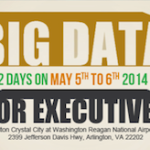Big Data for Executives 2014: Day 2 Highlights – KDnuggets

Highlights from the presentations by Big Data experts from McKinsey Solutions, SAP, Techfetch, Weather Analytics on Day 2 of Big Data for Executives 2014.
By Anmol Rajpurohit (@hey_anmol), May 29, 2014.
Big Data for Executives 2014 was a two-day event organized by Global Big Data Conference on May 5-6, 2014 specifically for the decision-making executives, and it addressed various questions everyone is asking such as: How can I leverage data to make better decisions across the enterprise? How well-positioned is my organization to take advantage of Big Data? What do I really need to get started? The focus of the event was on the application of Big Data rather than on the clusters, data warehouses, and coding that support it.
To help its readers succeed in their Analytics pursuits, KDnuggets provides concise summaries from selected talks at the event. These concise, takeaway-oriented summaries are designed for both – people who attended the event but would like to re-visit the key talks for a deeper understanding and people who could not attend the event. As you go through it, for any session that you find interesting, check KDnuggets as we would soon publish exclusive interviews with some of these speakers.
Highlights from Day 1 (Monday, May 5)
Here are highlights from Day 2 (Tuesday, May 6):
Jean-Bernard Moens, Founder & CTO, McKinsey Solutions gave a talk on “Thinking dynamically about the rapid pace of innovation in Big Data, when designing analytic systems”. He started by mentioning that it is not merely the size of data that matters. Rather, the size of data required itself depends on the specific situation. For example:
Often 100 data points are more than enough
Often value comes from combining data
In operations, often granularity matters
He stressed that we need to think dynamically forward. Referring to velocity, volume, variability and sophistication as the four major technological and architecture challenges of Big Data, he said that all of these cannot be solved by the same solution patterns. He demonstrated the key components of operational data architecture and analytical data architecture, focusing on the seamless integration of both to deliver advanced capabilities.
Data warehousing (DW) appliances have matured into enterprise-grade DW platforms. Business Analytics thrives on cheap horsepower offered by DW appliances, which are 20 times faster for less than half the total cost of patchwork systems. The increasing need for speed and exponentially decreasing DRAM prices are leading to the rise of in-memory analytics. Next, he discussed the importance of unstructured data warehousing, as nearly 95% of enterprise data is not structured. After discussing other components of architecture, he emphasized that there is a great need to:
Change mind-sets
Have a clear strategy
Have a killer plan
He concluded stating “Machine Learning is great but keep the humans involved”.
Imran Siddiqi, Principal at SAP America talked about how to develop strategy and build business case for Big Data. Even though Big Data is on the radar of leadership in every industry, it is hard to get organizational buy-in and successfully implement Big Data projects. The common challenges include lack of budget, lack of support from Finance, lack of resources, and inadequate information. He suggested focusing Big Data conversations on Business Value of the target benefits. In order to deliver real value, project planning needs to thoroughly evaluate:
Use cases
Information and application architecture
Standards and processes
People, skills and culture
Governance
Discussing about identifying business outcomes, he gave the following steps:
- Define/Refine Use Cases
- Data Discovery
- Initial Evaluation. Get started, experiment, and learn along the way
- Information Architecture Design
It is important to assess and identify capability gaps through Architecture Gap Analysis and Comprehensive Gap Analysis. Finally, talking about building a business case, he mentioned that Advanced Analytics provides answers that cannot be provided by traditional business intelligence. He also stated that shareholder impact and value of Advanced Analytics grows with ambitiousness of use cases.
Prabakaran Murugaiah, Founder & CEO of TechFetch gave an interesting talk titled “Needle in the hay – Finding, motivating, and retaining big data talent”. After outlining a brief history and current status, he shared the following talent trends for future:
- Shorter Product Development Cycle
- Global Team
- Level Playing Field (SaaS, PaaS, IaaS)
Emphasizing on the immense demand for Big Data professionals, he shared the report from Gartner stating that Big Data will create 1.9 million IT jobs in US by 2015. Sharing his thoughts on how to attract IT workforce, he suggested company professionals/recruiters to aggressively network, attend conferences, and create webinars & white papers. He concluded by giving the following tips for entrepreneurs:
Come out of comfort zone
Take calculated risk
Create opportunity for you & others
Bill Pardue, CEO, Weather Analytics delivered talk titled “Revolutionizing Weather Intelligence”. He mentioned that currently there is too much weather data available in an unorganized form, creating a big mess. Such data has the ability to rapidly, consistently, and globally transform business applications with Weather Intelligence through:
advanced technological integrations,
intuitive and smart visualizations,
robust and relevant convergence algorithms,
user-friendly APIs
He concluded his talk with use cases of intelligent weather data for engineering, insurance, telematics and national intelligence.
Related:
Big Data for Executives 2014: Day 1 Highlights
Gaming Analytics Summit 2014: Day 1 Highlights
Interview with Geoffrey Moore: Crossing the Chasm and Big Data
Read more:
Big Data for Executives 2014: Day 2 Highlights – KDnuggets

